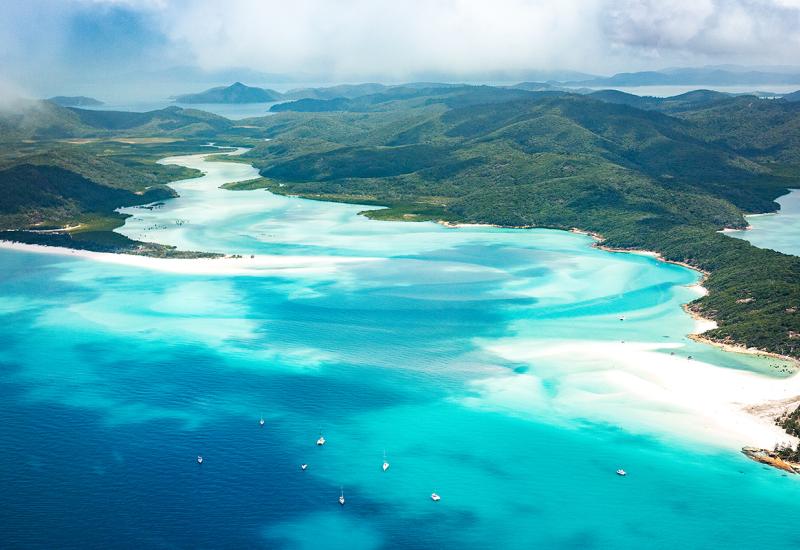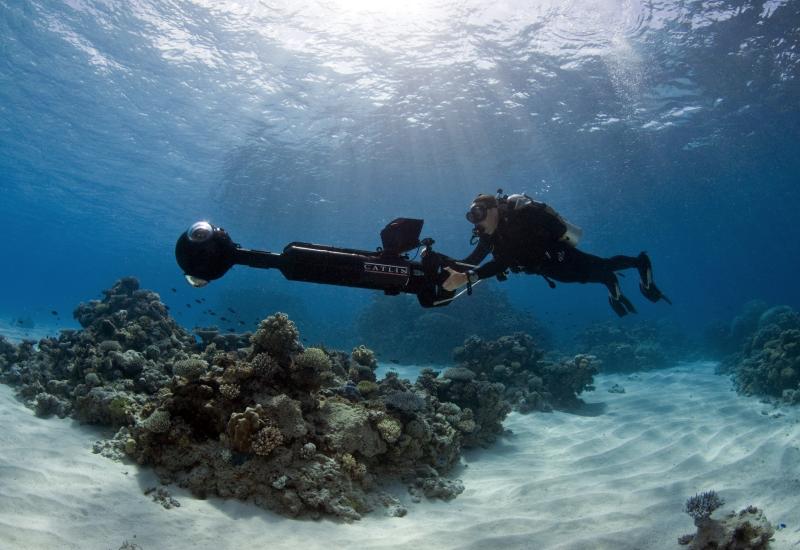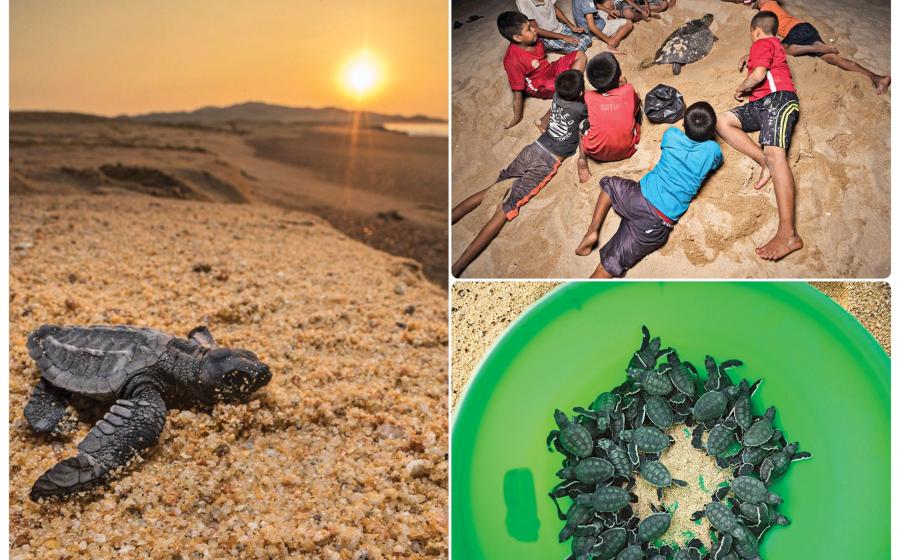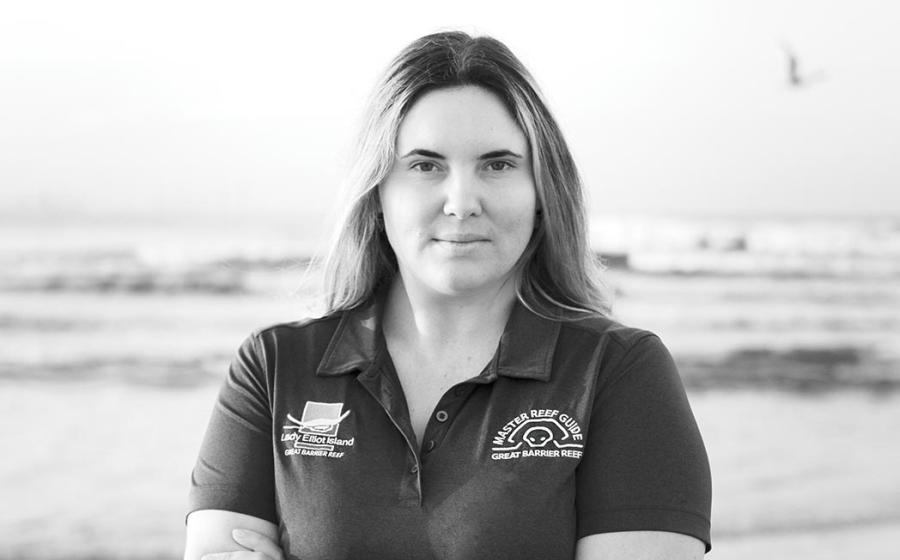Tahitian Fringe - Far Afield in a South Pacific Eden
Tahitian Fringe Far Afield in a South Pacific Eden
Some places never release their grip on us. There's no reason. Just like falling in love it happens. You don't understand it. After the buoyant rush of that first, wide-eyed discovery, if you're lucky, you realize just how complex a relationship will follow. For me, Tahiti is like that. I've had an ongoing love affair with these islands. I feel a strange comfort here: a life that's desirably uncontrollable. Not uncontrollable by the forces of the world's problems and stresses, but because life here exists in a perpetual state of adventure, romance and beauty the kind that constantly arouses the senses.
A symphony evolves before my eyes, une overture dans l'homage aux belles îles, as they would say in this French-speaking corner of the world. We edge into the pass, pulled by the first grip of incoming tide. The clicking sonar of dolphins resonates through us, building tension, urgency and curiosity like an overture. A silvertip ambles past. Overhead, a swirl of barracuda forms circles, figure eights and sinuous "S" curves.
With each kick into Fakarava's Garuae Pass, we move faster, flowing on the quickening drift. The press of the entire Pacific comes through the passes. On an incoming tide, the ocean's hand wraps you in its embrace and off you go, flying over the sea's hills and valleys, accompanied by the Tahitian undersea consorts: blacktip and gray reef sharks. The sharks show up suddenly, as if someone opened a gate, releasing them into the scene, weaving with an edgy nonchalance over the hard-coral seafloor as if it were their divine province. They move with grace and menace. In packs. By the dozen. And they have this uncanny, nerve-racking ability to appear from just behind you while you are still watching the group in front.
Halfway through the pass, we slip and weave through coral canyons until we reach a natural amphitheater and a respite from the current. We descend into a bright, vivid, flowing, moving world of dazzling, red clouds of big eyes and tightly packed rivers of blue and gold snapper. Every day, I think. I could do this every day and never grow weary of the thrill.
A few days earlier I'd come to the edge of the Earth: the fringe, a place where water and land exist in a tenuous accord.
The low-lying coral atolls of the Tuamotu Archipelago, one of five distinct regions of Tahiti, barely lifts itself from the sea. Sand and sea intertwine, a thin line between earth and water. On one side of the narrow strips of land, called motu, the vast Wild West of the untamed Pacific Ocean stretches out, rough and unpredictable, forever on the horizon. And on the other side is a lagoon of mirror-flat, civilized water. If there's such a thing as primal bliss, inspired by a place that pacifies and flusters your soul simultaneously with its feral beauty, it comes alive here.
We arrive at the dock at Le Maitai Dream Fakarava Hotel just after a brief rain shower. Still in that inspired emotional state from the sharks and the rush of the pass, I'm stopped by the aroma of tiare, hibiscus and frangipani flowers. Stirred, feeling expansive and buoyant, full of adrenaline from the dive and with a suddenness that one can encounter only in a place such as Fakarava, I feel life slow to stillness, as if I have tout le matins du le monde, all the mornings in the world, to accomplish whatever comes next. I want to sit by the lagoon, drift off into a sense of contented ease une vie heureuse, a happy life if only for a while. But right now I have a date with Oro, the Tahitian god of peace and fertility.
Black Pearls On the end of a wooden dock, we all strip down to our swimwear to follow Matthais Teihotaaia into the water. I've come to the Pearl Guest House Havaiki pearl farm to play the "pearl lottery."
If there's an industry here, it's cultivating black pearls. And Matthais is about to lead us into the water and out to the farm to pick our own oysters.
"Ceci est la seule ferme de perle où vous pouvez choisir votre propre perle," he says with a grin. This is the only farm where you can choose your own pearl.
So, we swim out to pick a string of pearl oysters, then gather at a table at the end of the dock as Matthais pries each one open. We all lean in close; the shells reveal round, teardrop and pure-black pearls that are said to choose us. Each one is unique, the perfect gift from Oro.
After dinner that night, I drag a lounge chair into the water and immerse myself half-in and half-out to witness a legion of stars awaken one by one from their slumber. Soon the sky is so dark and the lagoon so calm that all around me the reflected points of light dance on the flat surface of the water. On Fakarava, there is almost no line to differentiate water from land and from sky, and at that moment, I am in three places at once.
Transition in the Rush I fly back to the main island of Tahiti to catch the plane that will take me to Nuku Hiva in the Marquesas, a 1,200 mile distance. Between flights, I catch a taxi to the harbor in Papeete to get lunch at the roulottes: food vans and trailers that offer an inexpensive meal.
You won't find many tourists here; it's almost exclusively locals. I order a savory crepe filled with cheese and grilled chicken and a dessert crepe filled with Nutella, and eat amid the hustle and commerce. Horns honk, the waft of exhaust fumes masks the floral aromas I'd come to expect, and people rush. After Fakarava, the noise, flow, energy and movement of Papeete clings to my ears like lead. But I like the liveliness of cities sometimes, and I'm still in Tahiti. As I eat, I consider how far I will be from this bedlam of modern life in a few hours.
The Land of Men Lightbeams and shadows and silky haze. Mist-shrouded peaks. The steep-spired, waterfall-riven islands called Henua Enana, the "Land of Men," seem to materialize from a shroud of imagination. They're craggy, feral, extraordinarily beautiful and serene. Like much of Tahiti, they're a conundrum: These islands have the kind of untamed stillness one feels when gazing into a dark night sky, and yet, because there is no barrier reef, they take the full onslaught of the Pacific the waves, currents and wind. Underwater, it's one of the planet's true last frontiers.
The Marquesas sit 745 miles from Papeete and even farther away in time. I arrive late afternoon in Taiohae, the main village, check into Keikahanui Pearl Lodge, grab a bike and ride down the hill into town. It's Sunday, so many of the locals are on the beach, with their horses tied to trees in the shade. Horses roam freely throughout the island, and Nuku Hivans ride horses as much as they do scooters or cars. Probably more.
The island evokes something within me, a response that I've never felt other places. It feels like I'm standing on the far edge of the planet, surrounded by secrets. There's something startling in the air.
I stop at Temehea Tohua, a restored ceremonial site next to the bay. Sculpted stones inspired by island legends tell me I've arrived in a place quite separate from the rest of Tahiti. Here, the sculptures all evoke the same countenance and look like the little green men we think of when we imagine the occupants of UFOs: big, almond-shaped eyes, small in stature. Were I prone to believing in extraterrestrials, the statues and Tikis here would confirm my convictions.
Several riders on horseback pass through the site, past the statues and the sea, and onto the same road with the scooters and Land Rovers. I continue into town, then turn up the road that leads to the Notre Dame of the Marquesas church, built with stones from six different Marquesan islands.
An odd and perhaps uneasy mix of religious cultures is on display inside. Jesus of Polynesia stands atop a carved wooden Tiki. The disciples guard the church as Marquesan warriors and a blend of Chirstian and Marquesan gods hover above Mary's head. George Bernard Shaw once said, "You must get to a man through his own religion." A paean to that statement, the Notre Dame of the Marquesas is a remarkably contradictory fusion of the sacred and profane symbols of a Christian world. Although the missionaries tried to obliterate tattoos, singing, dancing and most of the island's culture when they swept through, they have survived, despite, and now flourish on deep taproots of memory among the people here.
But, the missionaries had no influence beyond the shore and, off Nuku Hiva, there's a land of giants. The Tahitians have a term for the sea: moana. And here, the moana breathes, feels joy and pain, and has flights of fancy, hosting vigorous world of marine life.
The divemaster and I head out to find the resident melon-headed whale pod, several hundred strong. The only known place on the planet where this happens is here. On the way, we pass a current line, where cooler and warmer waters collide. Here, swirling, somersaulting and weaving with mouths agape are several mantas.
We find the whales and jump into the water to snorkel with half a dozen.
It's moments like this that keep driving me to the sea, because these experiences are so ancient and honest and authentic. The whales come in close, curious on their terms, then venture off, like heralds coming to announce to us that Nuku Hiva will be unlike anything we've ever seen.
We enter Ekamako Cave, not too far from the mouth of the bay in Taiohae, later in the day. Here, dozens of stingrays carpet the sand floor, seeking shelter and rest. Watching over them, from literally every crack and crevice, are countless, massive lobsters. Venturing through the cavern, we find pockets of trapped air and places where fresh water causes haloclines of hazy water. It's an easy dive.
Even between dives I am mesmerized. From the sea, the island rises like a fortress or a natural cathedral, with spires and buttresses and imposing cliffs. Riding thermals, seabirds streak bright white against the green of the cliffs.
"C'est incroyable," I effuse to myself as I watch the island wrapped in the strange light that seems to exist only here on Nuku Hiva. It's like a shield, protecting its secrets.
"You like Tahiti?" the divemaster asks.
"Oui, c'est une jolie île," I reply, "avec gros aventure."
The divemaster grins, and asks me if I'm ready for the next "gros aventure."
We descend onto Hammerhead Point. At first, it's the dragon morays that grab our attention, but soon the megafauna arrive. Manta rays and spotted eagle rays come in quick succession, two each, as if looking for Noah's Ark. It's not until after the dive that I realize the namesake hammerheads had not joined the parade.
I meet up with Jean-Pierre the next morning to hike Hakaui Valley to the Vaipo Waterfall, which drops 1,148 feet to the valley floor. After a short boat ride from Taiohae to Daniel's Bay, we strike out at a leisurely pace. Jean-Pierre stops at mango, papaya and pamplemousse trees, all of which bear fruit sweeter than any I've ever enjoyed.
We continue past emerald citadels that rise abruptly and then disappear into a cloud curtain. A path takes us along a river through ancient forests of kapok and banyan. Birds are everywhere. The valley walls squeeze in to where they're only about 100 feet apart. We walk through a surreal, electric-green field of ferns and yellow pacolo flowers, and then arrive at the waterfall's pool, where the water arrives as a mist. The pool is inhabited by a lone eel.
"Le lieu a le pouvoir," Jean-Pierre tells me. This place has power.
And it does.
Huahine Tahiti has three forms of welcome: maeva, which means to welcome the whole, mararuu, which is to welcome a group, and ioarana, which welcomes the individual. So the marae, near the town of Maeva and along the shores of Lake Fauna Nui (with more than 30 marae), hold special meaning. Positioned at the eye of the Roads of the Wind, the northwest wind, this site, I'm told, welcomed the first visitors to the Society Islands. It's studded with wooden poles called unus carved with stories of the messengers of the gods, of the tiis and the spirits, of travel, tapu and the turtle. Tradition holds a strong grip on this island.
Days here are lived in ordinary Polynesian rhythms. It's hard not to feel at home, instantly, upon arrival at Huahine. I encounter story after story of people who'd come here and simply stayed. One of them is Annie Brunet, owner of PADI Dive Resort Mahana Dive in downtown Fare. Firmin, my guide for the day, drops me off, promising to fetch me at dinnertime.
Annie's favorite site in all of the Society Islands, Avapeihi Pass, is 10 minutes from her door. She has logged hundreds of dives there, and yet, as we motor to the site, she's giddy. She tells me in rapid-fire French about sharks, rays, jacks, cleaning stations and barracuda. Each pause is quickly filled with another marine critter or coral garden. By the time we moor, my head is already swimming with images. So the three of us me, Annie and her unbridled enthusiasm roll into the water. Immediately, we're accosted by a bright-yellow-and-white storm of butterflyfish, surgeonfish and unicornfish. They follow us, like a comet's tail trailing in our wake, into the pass. A manta ray flies overhead, as if to show the way. Just as we get to the drop and the current, a spinning wheel of tightly packed Pacific barracuda moves in like a giant halo.
Annie starts to motion, and we settle in behind a coral head as several spotted eagle rays line up at a cleaning station. If you just pause here, the marine inhabitants will come to you. Within minutes gray reef sharks have gathered. Spadefish cruise overhead, along with dogtooth tuna and more eagle rays.
Even underwater, Annie's excitement is contagious. But she didn't oversell. It's all there, including a fish she didn't mention: a friendly Napoleon wrasse. I thought for a moment it was coming in to give me a bisou, a kiss.
After an exhilarating dive, Annie and I make plans to dive this several more times. She beams.
In town, Firmin joins us at Snack Bar Te Marara, locally called Edna's. We sit at a table on the sand overlooking Heameae Bay and order Hinano beer, sweet grilled vanilla mahi-mahi and a tangy poisson cru, Tahiti's national dish that's similar to ceviche. While we eat, Firmin shares the story of Ta'aroa, the god who had such procreative powers that he originated the land and sea, day and night, and the idea of all things by simply embracing a rock. I ask about its location.
"A pourtant être su," he says. It's yet to be known.
After a few more Hinanos, my head spins with stories. I say goodbye and walk to the dock to catch a water taxi back to Te Tiare Beach Resort. The resort has no roads and is reachable only by water taxi from Fare, so the sense of escape is complete here. The moana in the lagoon is flat and polished, reflecting the night like a shiny metal surface. Firmin has told me that good things come, fanau po, born of the Tahitian night. I wade out into the lagoon and float on the water.
The next morning starts with a bolt of adrenaline. I rent a jet ski for an island excursion. It's exhilarating. The island looks tres sauvage, primal, original. I'm told there are places here that have never felt the foot of man. It's easy to imagine.
We stop for lunch at a place called Maurii, arriving just in time to see the end of a round-the-island outrigger canoe race. Local women in traditional dress greet the competitors. Drums pound out a quick, urgent beat to spur on the audience and the competitors. The aroma of meat on the grill fills the salt air, and everywhere I look, life is good.
"Une vie heureuse," Maurii's French owner tells me a happy life; an oft-repeated phrase in Tahiti. It's here where life, the land, family and the sea entwine.
The drum beats rise. The first outrigger rounds the point. And the women, giggling and smiling in their bright pareas and flower garlands, wade into the lagoon to greet the winner.
Special thanks to Huahine Te Tiare Beach Resort (tetiarebeachresort.com), Keikahanui Nuku Hiva Pearl Lodge (pearlresorts.com), Le Maitai Dream Resort (pacific-resorts.com), ResortQuest Mahana at Kaanapali (themahana.com) and Tahiti Tourism (tahiti-tourisme.com).
Deco Stops Feed the sacred blue-eyed eels of Faie on Huahine. Then, go marae (sacred, historical site) crazy: Many line the shores of Lake Maeva and Lake Fauna Nui. Check out the rockfish traps at the mouth of Lake Fauna Nui. They've been catching dinner here for more than 500 years. Have dinner at Maurii, which was built by an artist in homage to the myth of Huahine. Explore the Huahine Pearl Farm, which sits on a floating platform right in the lagoon. On Fakarava, follow the trail of the black pearl at the Hinano Pearl Farm or snorkel out and pick your own at the Pearl Guest House Havaiki pearl farm. Take a boat to the far southern end of the Fakarava lagoon to tour the quaint village of Tetamanu. While there, head out to a motu for a picnic, and snorkel with the rays and butterflyfish. On Nuku Hiva, hire a guide and tour the breathtaking Taipivai Valley, then head over to Hatiheu to see Herman Melville's favorite beach before heading in the hills to explore the vast Hikokua and Kamuihei tohua (archeological sites). If you're feeling saucy, hike one of the world's highest waterfalls, the 1,148-foot Vaipo Waterfall. To really bring something authentic home, get a Marquesan tattoo from Jean-Yves in the main village of Taiohae.
The Guide to Tahiti Average water temperature: 78-84°F What to wear: shorty in summer, 3 mm fullsuit in winter Average visibility: 80-150 feet When to go: year-round; February brings the most rain.
Must Do The Huahine Double: Take a personal watercraft and see Huahine from the lagoon. Get lunch, a pearl- factory tour and a heap of cultural stories. Then touch the cultural heart of Huahine by feeding the sacred blue-eyed eels that reside in the village of Faie.
Must Dive Avapeihi Pass (Huahine): Settle in behind a coral head and watch as eagle rays, sharks and giant schools of barracuda pass.
Ekamako Cave (Nuku Hiva): A carpet of stingrays settles in the sand of this large cavern. Lobsters watch the scene. And there are even several air pockets.
Pygmy Orcas (Nuku Hiva): Off the east coast of Nuku Hiva, there's a resident school of melon-headed whales that numbers in the hundreds. Get up close to these unique mammals.
Garuae Pass (Fakarava): You like sharks? Lots of them? Then this thrilling pass dive is for you. Plus, there are manta rays, dolphins, Napoleon wrasse and massive schools of snapper and bigeye.
Tumakohua Pass (Fakarava): This southern-end pass fills with blacktips and gray reef sharks, which you'll encounter at speeds of up to 5 knots on the incoming tide. Manta rays and swirls of barracuda and jacks patrol the entrance.
Must Have Black Pearls: The waters off Tahiti are a magic potion for black pearls. The world's best come from these strikingly beautiful island lagoons. The only place where you can choose your own is the Havaiki pearl farm on Fakarava. havaiki.com
Rigged & Ready ScubaTubeSocks: With a vibrant selection of colors and patterns from which to choose, Scuba-TubeSocks allow you to express yourself. They're great for full-foot fins to help prevent blisters. scubadorag.com
Tahiti Listings Air Tahiti Nui flyatn.com
Tahiti Tourism tahiti-tourisme.com
Dive Centers Aquatica Dive Center aquatica-dive.com
Bathys Diving Polynesia bathys-diving.com
Eleuthera Plongee Tahiti dive-tahiti.com
Dive Resorts/Hotels Bora Bora Lagoon Resort & Spa boraboralagoon.com
Pearl Resorts & Spa pearlresorts.com
TOPdive/Sheraton Hotel Tahiti topdive.com










